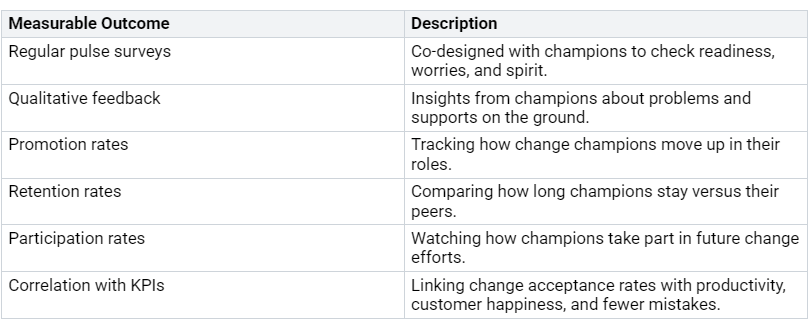Empowering Champions Networks are crucial for encouraging product usage and maintaining engagement. These networks consist of enthusiastic individuals who advocate for change within their organizations. They foster collaboration by guiding others and enhancing communication across teams. Research indicates that companies with official champion programs experience significantly better outcomes, including a 106% increase in social media activity and improved community involvement. By investing in Empowering Champions Networks, you can create a supportive environment that inspires everyone to achieve goals collectively and implement lasting changes.
Key Takeaways
Champions Networks help people use products more and get involved by encouraging teamwork and talking with each other.
Champions have important qualities like being creative, motivated, and good at socializing. These traits help them make changes happen well.
When we include champions in managing changes, it improves communication, builds trust, and makes project success more likely.
Giving training and praise to champions makes them better at their jobs and keeps them excited to help with changes.
Checking how well champions networks work using key performance indicators shows what they do well and what needs to get better.
What are Champions Networks?
Champions networks are groups of excited people. They support change in their organizations. These networks are important for getting people to use new products and stay involved. They help make a friendly place where workers feel confident to try new ideas and ways of doing things.
Key Characteristics
Good champions have special traits that help them create change. Here are some common qualities of champions:
Champions know a lot and are creative. They like to test new ideas.
They are ready to take chances and break some rules.
They do not always follow the usual way of doing things.
Champions usually have more experience and are very motivated.
They believe in themselves, can persuade others, and handle uncertainty well.
They have good social skills and know how to build teams and get resources.
They imagine new ideas and help make them happen.
They build groups and agreements, which are important for success in innovation.
These traits help champions encourage their coworkers and support new projects.
Role in Change Management
Champions networks connect the change management team with workers. They promote change and explain its benefits clearly. By helping coworkers during changes, champions improve the whole change process. Organizations that use change agent networks are more likely to reach their project goals. Change agents help with communication and support, which are key for accepting change.
The Prosci ADKAR Model shows important parts that change agents help people achieve during changes. By adding champions to your change management plan, you can build a more involved workforce ready to face new challenges.
Importance of Empowering Champions Networks
Empowering champions networks are very important for successful changes. These networks help you make changes and get people involved while boosting employee spirit.
Drive Change and Adoption
Champions networks lower the problems that come with starting new things. They find issues that slow down progress and fix them well. By keeping their eyes on the goals, champions make sure that change stays important, even when there are other things to focus on. Their help keeps the work going after the first steps, which helps projects grow and improve.
Here are some key ways champions drive change:
Also, champions improve communication between leaders and workers. They explain why changes are happening, helping everyone see the benefits. This open talk builds trust and lowers resistance, leading to more people accepting changes.
Enhance Engagement and Morale
Empowering champions networks also raise employee involvement and spirit. When you include champions in the change process, you create a culture where people feel capable. Employees feel more sure of themselves when facing new tasks and tools. This confidence leads to more involvement, as employees join in on change efforts.
Measurable outcomes of empowering champions networks include:
In a recent study with nearly 65,000 employees, researchers found that having well-being champions led to better feelings about personal and company well-being. This good effect on spirit was seen across different jobs and places. By creating a supportive space, champions help build a culture where employees feel appreciated and involved.
Strategies to Engage and Empower Champions
Getting champions involved and giving them power is very important for any change project. You can use different methods to help your champions grow and succeed.
Training and Resources
Training and resources are key to getting champions ready for their jobs. Focus on giving them training that covers more than just the basics. Here are some good training ideas:
Implementation Science: Teach champions about how to make changes happen. This helps them deal with problems better.
Team Capacity Building: Give champions skills to improve teamwork. This helps everyone feel responsible for their work.
Interpersonal Skills: Help champions improve their communication and relationship skills. Good communication is very important for change champions. They need to share their peers’ concerns with management and explain how changes will affect daily tasks. This builds trust and creates a friendly space for change.
You should check regularly to make sure champions are learning the right skills. Ongoing help from mentors can also boost their confidence and effectiveness.
Recognition and Support
Recognizing and supporting champions greatly affects their motivation and performance. When you appreciate their hard work, you create a positive culture that keeps them engaged. Here are some good ways to recognize champions:
Specific and Timely Recognition: Praise individual achievements quickly. This lifts spirits and strengthens their commitment to the organization.
Connect Contributions to Goals: Make sure recognition relates to the organization’s goals. This helps champions see how their work matters.
Foster a Positive Work Culture: Encourage appreciation to spread throughout the organization. When employees feel valued, they are more likely to accept new ways of working.
Think about starting programs like “Champion of the Month” to celebrate successes. This not only motivates champions but also encourages others to get involved and support champions in the organization.
By mixing good training with recognition and support, you can create a strong environment where champions can succeed. This method builds a culture of teamwork and ongoing improvement, leading to successful change projects.
Building a Change Champion Network
Making a good change champion network needs careful planning and action. You should pay attention to two main things: support from leaders and a clear vision with specific goals.
Executive Sponsorship
Support from leaders is very important for your change champion network to succeed. When leaders back the project, they help create a culture where everyone feels responsible and involved. Here are some key parts of good support:
Authorization: Leaders must allow and help make changes in the organization.
Clear Vision: They should understand why the change is needed.
Public Support: Their visible backing encourages others and helps get commitment to the change.
By having strong support from leaders, you build a strong base for your change champion network. This backing helps champions take action and lead change well.
Clear Vision and Goals
A clear vision and specific goals are very important for building a champion change network. You need to explain the purpose of the change and what you want to achieve. Follow these steps to make things clear:
Planning: Begin by planning and creating your change management strategy.
Identifying Champions: Work with managers to find possible change champions and other change helpers.
Defining Roles: Clearly state the roles and responsibilities for each champion in the network.
Establishing the Network: Build and manage the champion and change helper networks to ensure good teamwork.
By focusing on these steps, you can create a well-organized change champion network that boosts involvement and supports successful change projects.
Integrating Champions into the Flow of Work
Putting champions into your daily work is very important for getting the most out of them. You can do this by connecting their work with your organization’s goals and setting up good ways to give feedback.
Aligning with Organizational Objectives
When you connect champions with your organization’s goals, you guide their work toward shared aims. This connection helps teams work together and removes barriers between departments. Here are some good things about this method:
It makes sure champions work on projects that match big goals.
You use resources better, saving money and getting good results.
Clearly explaining goals helps everyone talk openly, which boosts teamwork.
By including champions in your daily tasks, they can show how to use evidence-based practices regularly. Their regular talks with coworkers and leaders help them understand the local culture and workflow better. This way, champions can teach and support their teammates when needed.
Creating Feedback Mechanisms
Feedback methods are very important for helping champions in their jobs. They let you check progress and make changes when needed. Here are some good feedback methods you can use:
Real-time feedback tools
Regular one-on-one meetings
360-degree feedback
Peer reviews
Self-assessments
These methods help improve champions networks all the time. For example, step-by-step feedback and help give different levels of support, creating a culture of constant improvement. Watching behaviors makes sure champions follow best practices, keeping the program strong and on track. Also, including everyone in decision-making lets champions share different views, boosting their ownership and involvement in the network.
By putting champions into daily work and setting up strong feedback methods, you create a place where they can succeed and make real changes.
Measuring the Impact of Champions
It is important to measure how well champions networks work. This helps you understand their success. You can use different key performance indicators (KPIs) to see how these networks promote change and involvement.
Key Performance Indicators
Here are some common KPIs to think about:
Amount of coaching or training needed
Time available for champion network activities
Success in meeting champion network goals
These indicators help you check how ready and effective your champions are. By keeping track of these metrics, you can find strengths and areas that need improvement in your network.
Continuous Improvement Strategies
To make champions networks better, you should use continuous improvement strategies. Here’s a table with some good methods:
By using these strategies, you can keep your champions network active and responsive to your organization’s needs. Regularly measuring impact and making changes will help you succeed in driving change and boosting engagement.
Empowering champions networks is very important for making changes and improving involvement in your organization. These networks help people work together and support each other, which leads to better success in getting people to adopt new ideas. To include champions well, think about these easy steps:
Explain the network’s purpose to make its goals clear.
Choose the right champions based on their influence and variety.
Set clear expectations to avoid confusion.
Give training and resources to help champions succeed.
Create ways to communicate for regular engagement.
Recognize and reward participation to boost motivation.
By following these steps, you can build a strong environment where champions can do well. Their work will build trust, create connections, and open new chances for everyone involved.
Remember, a good leadership model focuses on ongoing growth and new ideas for lasting success.
FAQ
What is a champions network?
A champions network is a group of excited people in a company. They support change, help their coworkers, and share new ideas. Their role is very important for getting people to use products and keeping employees engaged.
How do champions help with change management?
Champions help share information between bosses and workers. They explain why changes are good, answer questions, and offer help. Their involvement makes it more likely that changes will succeed.
What qualities should I look for in a champion?
Look for champions who know a lot, are eager, and can communicate well. They should be open to new ideas and inspire others. Good social skills are key for building trust and teamwork.
How can I recognize and support my champions?
You can recognize champions by giving them praise and rewards quickly. Provide them with resources and training to improve their skills. Create a positive culture that appreciates their work and encourages them to stay involved.
Why is executive sponsorship important for champions networks?
Executive sponsorship gives visibility and resources to champions networks. Support from leaders helps create a culture of responsibility and commitment. It allows champions to lead change effectively and keeps them aligned with company goals.














